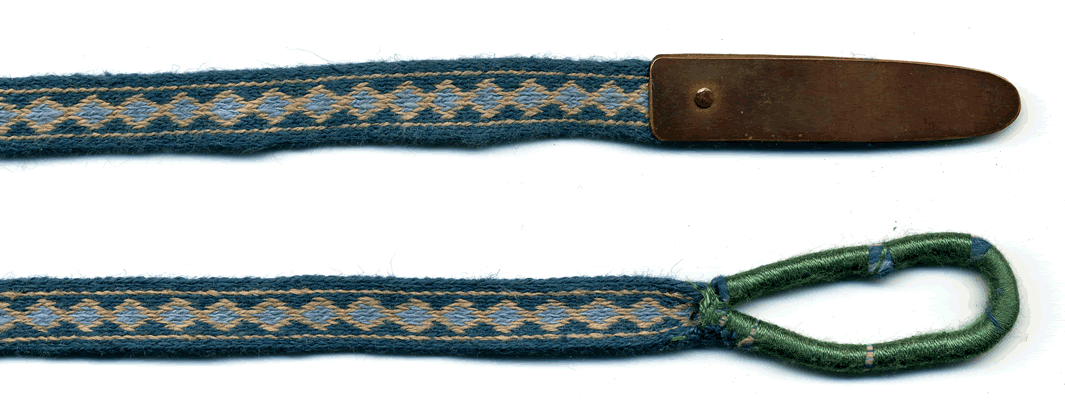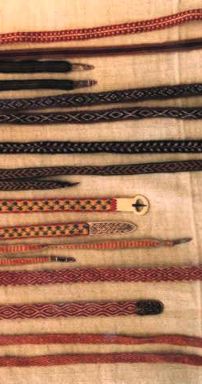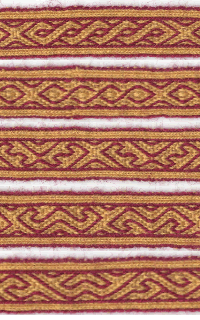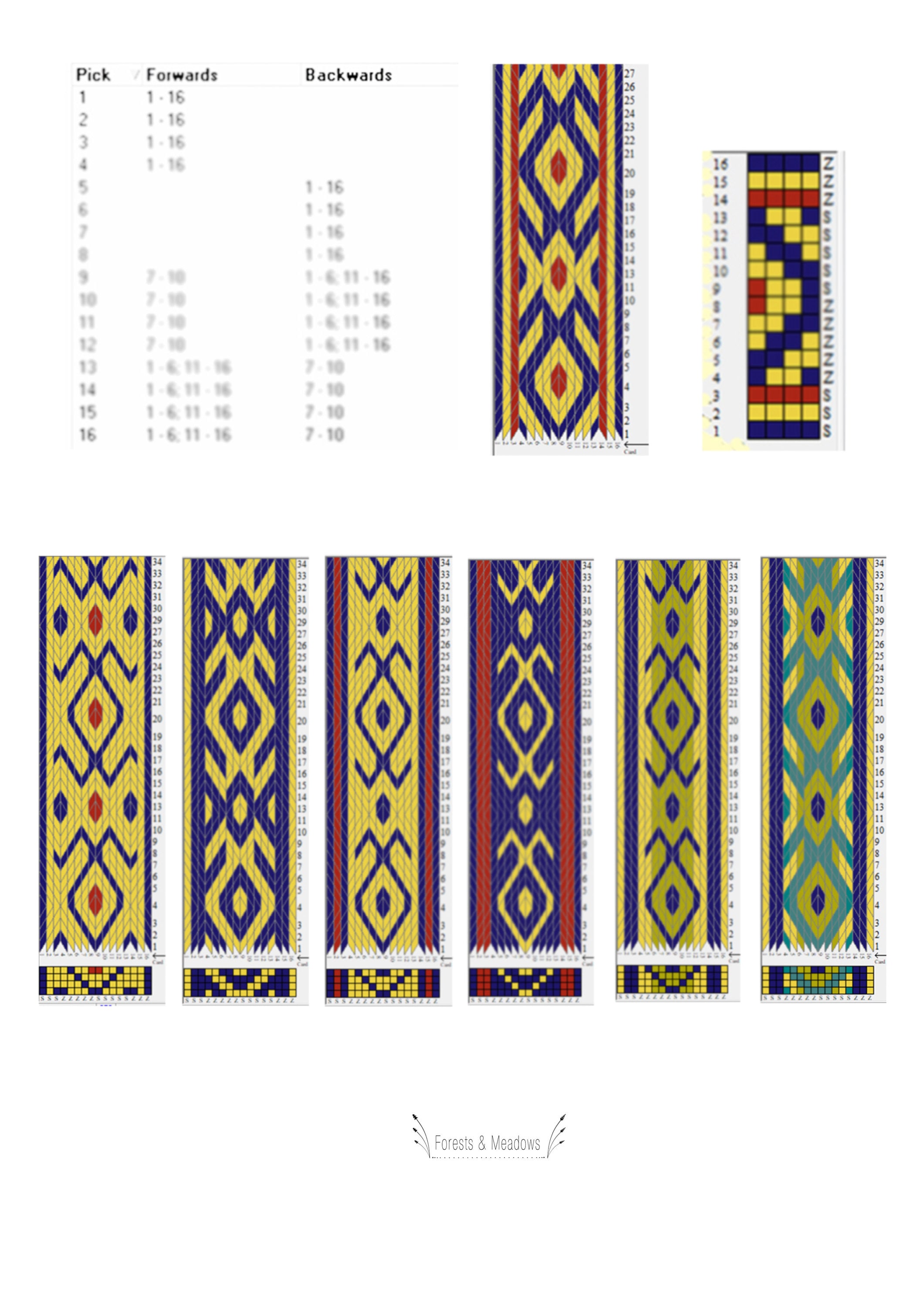Additionally most Anglo-Saxon tablet-woven finds have been plain one-colored weaves with or without additional brocading but this piece is in an uncommon weave containing an uncommon number of colors--three. Twisting a tablet works by turning it around the axis that runs across from the AD edge to the BC edge of the tablet the warp threads swap from S to Z threading or vice versa and the AD and BC positions are swapped.
Anglo Saxon Diagonal Greek Key Tablet Weaving Doing It Wrong
Grace Crowfoot published an analysis of the weave in 1951.

. Anglo-Saxon Card Weaving Late celtic Iron Age wooden cards cart find from Dejbjerg Denmark I have been interested in Card or Tablet weaving for a number of years. It is a very easy way to bring color pattern and interest to your clothing. Most belt finds have been leather.
CROWFOOT TABLET weaving has been popular in the north from the early AD centurie I. Tablet weaving also known as card weaving is an ingenious technique for taking long bundles of warp threads and passing them through perforated tablets then manipulating these to make strong patterned bands. Weaving is slow but the results are pleasing.
Find deals on weaving patterns on Amazon. The tablets are held in the hand like a pack of cards parallel to the warp and turned backwards or forwards by half or quarter turns. Collingwoods book is the bible for the techniques.
She dated it as being Saxon late pagan which would be around the fifth or sixth century AD. ANGLO-SAXON TABLET WEAVING By GRAC ME. It is with these thoughts that I began.
Dark Age Tablet Weaving for Viking and Anglo-Saxon re-enactors 1 Introduction Tablet weaving also known as card weaving is a method of using square tablets with holes in the corners to weave narrow decorative bands made of wool linen or silk threads. So we are turning our backs on the term Anglo-Saxon. Band completed 10232002 What it is This tablet woven band is woven using 18 tablets each with 4 strands of size 10 cotton crochet thread a total of 72 threads using the method described as Pack Idling by Peter Collingwood in The Techniques of Tablet Weaving using Thora Sharptooths threading sequence from her website.
It is most appropriate then that the first examples of tablet weav-. Continental evidence can be used as guidance for Anglo-Saxon tablet weaving in this period. Tablet weaving was also very popular with the Anglo-Saxon peoples.
A linen fragment was found attached to a square-headed bronze brooch in an Anglo-Saxon burial ground at Laceby Lincolnshire. The term Anglo -Saxon has been co-opted by white supremacists. Unfortunately the pattern variations are not as numerous as in tablet weaving.
T is present for example in the well-developed tablet braids and edgings of the Torsberg find from Schleswig and therefore might be expected to occur in Anglo-Saxon remains. Historically this was done with either a back strap method or a structured loom. Germany and the Saxons from Lower Saxony in northern Germany were migrating to the island of Great Britain at the time such as the Jutes from Juteland now a part of Denmark.
Getting Started with Tablet Weaving. See more ideas about tablet weaving patterns tablet weaving weaving patterns. Pattern looks good 10 into the trim.
Unlike most historic bands the tablets were individually threaded with different coloured threads. Tablet weaving was widespread in Europe and Britain in the first millenium AD and is an excellent. Like tablet weaving inkle weaving is restricted to narrow widths although as it is woven on a loom it is much quicker and easier.
Jacquard-like weaving can be done on cards see Collingwoods medieval examples but man its tedious and slow. The find was dated to about 600 AD. This tablet woven band is woven using 18 tablets each with 4 strands of size 10 cotton crochet thread a total of 72 threads using the method described as Pack Idling by Peter Collingwood in The Techniques of Tablet Weaving using Thora Sharptooths threading sequence from her website httpwwwcsvassareducapriestsaxontwhtml.
For archeological examples of the resultant clothes I like Penelope Rogers and Gail Owen-Crocker books you knew early Anglo-Saxons were Scandinavian right. Jan 20 2015 - View weaving draft - Anglo-Saxon 6d created by Stell Michelsen. To begin with it is rare to find evidence for tablet-woven belts from the Saxon era.
Tablet weaving is one of the oldest European textile techniques traceable to at least the early iron age. At least I am. Ad Browse discover thousands of brands.
My Gallery shows some of the bands Ive woven over. As we get further into the work you can see the twist accumulating and the tension beginning to vary even with frequent pauses to work out the twist. These instructions describe how to weave Grace Crowfoots reconstruction of the pattern a minor variation of the same and also two motifs from the later Maaseik tablet weaving that can be woven on the same warp set.
The fibres appear to be bast and the dimensions and cross markings of the fibres indicate that they may be linen. Although the origin of the word is unknown an inkle is a coloured tape or braid similar to the braids produced in tablet weaving. Working out the twist is time consuming.
A threaded-in pattern from an early Anglo-Saxon or mediaeval find Description A small piece of linen1 tablet weaving was found attached to a bronze strap-end in St Johns Cricket Field Cambridge. Read customer reviews find best sellers. Apr 27 2017 - Explore Bonnie Harvey Alesia Gillefals board Medieval Tablet Weaving Patterns tutorials followed by 247 people on Pinterest.
Your average Viking man or woman would have considered themselves seriously underdressed if they didnt have some nice decorations on their clothing probably including tablet woven bands. The extent of tablet-weaving in the early Anglo-Saxon period on the continent at this time and in mediaeval England suggests that tablet-weaving was a popular craft at all levels of society perhaps particularly where there was a Scandinavian influence. Grace Crowfoot gave a detailed description of the fragment of tablet-weaving found in St Johns Cricket Field Cambridge Figure 1.
What it is. The tablets are small flat squares usually of bone or wood with a hole in each corner through which a warp thread is passed. Tablet weaving also known as card weaving is an ingenious technique for taking long bundles of warp threads and passing them through perforated tablets then manipulating these to make strong patterned bands.
Historically this was done with either a back strap method or a structured loom. To weave with this technique each card is normally. To weave with this technique each card is normally.
On an inkle weaving loom alternate warp. Find various weaving drafts designed by members of Weavolution.

Silk Tablet Weaving Anglo Saxon Style Stock Photo Alamy

From Wulfheodenas Tablet Weaving Based Upon Sutton Hoo Braid Tablet Weaving Card Weaving Weaving Patterns
Anglo Saxon Threaded In Pattern Research Dumping Grounds

Regia Anglorum Anglo Saxon And Viking Crafts Braid Weaving

Shelagh S Website Patterns From The Past
Anglo Saxon Diagonal Greek Key Tablet Weaving Doing It Wrong

Anglo Saxon Belt Weaving Instructions

Tablet Weaving Patterns Viking Trim Pattern Viking Belt Etsy Uk
0 comments
Post a Comment